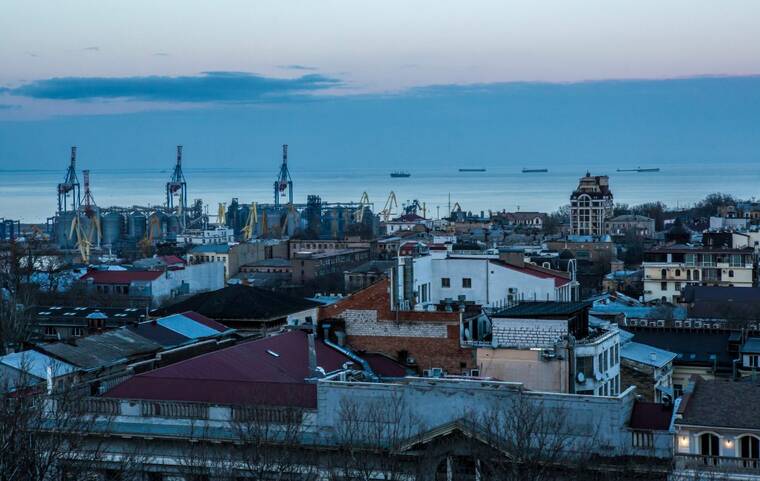Russia, Ukraine agree to halt Black Sea fighting, White House says

OKSANA PARAFENIUK/THE NEW YORK TIMES
The Port of Odesa in Odesa, Ukraine, in March 2024. In what would be the first significant step toward a full cease-fire, Ukraine and Russia have agreed to cease fighting in the Black Sea and halt strikes on energy facilities, the Trump administration claimed today.
The White House said today that Ukraine and Russia had agreed to cease fighting in the Black Sea and to hash out the details for halting strikes on energy facilities. It would be the first significant step toward the full ceasefire the Trump administration had been pushing, but it still would fall short of that goal and it remains unclear how and when this limited truce would be implemented.
Both Ukraine and Russia confirmed the agreement, although it appeared to come with some serious caveats on the part of Moscow. In a statement about the talks, the Kremlin said it would honor the agreement only after its state agriculture bank is reconnected to the international payment system and restrictions are lifted on “trade finance operations,” which are some of the penalties imposed after Russia invaded Ukraine in 2022.
In a statement about the U.S.-Russia talks, the White House appeared to agree with at least some of the conditions, saying it “will help restore Russia’s access to the world market for agricultural and fertilizer exports, lower maritime insurance costs, and enhance access to ports and payment systems for such transactions.”
The agreements came after three days of intense negotiations in Riyadh, the capital of Saudi Arabia, during which delegations from Ukraine and Russia met separately with U.S. mediators.
The White House released two different statements saying it had separately struck deals with Ukraine and Russia on the maritime and energy attacks. The statements added that the U.S., Ukraine and Russia welcomed the involvement of third countries in “supporting the implementation of the energy and maritime agreements.”
Although the agreements marked a breakthrough in the White House’s efforts to reach a ceasefire, even limited, in Ukraine after three years of full-scale war, they did not appear to extract major concessions from Russia, the aggressor country.
Don't miss out on what's happening!
Stay in touch with breaking news, as it happens, conveniently in your email inbox. It's FREE!
Ukraine and Russia have an interest in stopping strikes on their respective energy facilities, which have caused pain for both sides. Russia, in particular, stands to gain from a ceasefire in the Black Sea, where repeated Ukrainian attacks have forced its navy into retreat.
While President Vladimir Putin of Russia has portrayed himself as being open to demands from President Donald Trump, like halting the strikes on energy facilities or security in the Black Sea, they are goals that the Kremlin has in the past pursued and seen as beneficial to itself.
Putin rejected an earlier proposal from the United States, which Ukraine agreed to, for a total 30-day ceasefire. He said a broader truce would have to include a halt to Western military aid to Ukraine and to the country’s mobilization efforts — two conditions that are nonstarters for Ukraine.
Ukraine and Russia are now expected to hammer out details for implementing the maritime and energy ceasefire. Ukrainian Defense Minister Rustem Umerov, who led his country’s delegation in Riyadh, said “additional technical consultations” would have to be held as soon as possible for “the implementation, monitoring and control of the arrangements.”
Both countries had already agreed last week to halt strikes on energy facilities, but they had yet to implement the agreement and quickly accused each other of continuing attacks on energy sites.
Strikes on energy facilities have been central to each side’s efforts to weaken the other throughout the war. Russia has pounded Ukraine’s power grid, aiming to make life unbearable for civilians and hinder its war effort. Ukraine has repeatedly struck Russian oil facilities to try to choke off revenues fueling Moscow’s military operations.
Both Russia and Ukraine also rely on the Black Sea for commodity exports. In mid-2022, they brokered a deal allowing Ukraine to ship grain through the sea, but Russia withdrew from the agreement a year later, arguing that Western sanctions were severely limiting its ability to export agricultural products.
Russia then threatened all commercial vessels heading to and from Ukraine, aiming to strangle its seaborne exports. In response, Ukraine’s military started a campaign that pushed the Russian navy out of the western parts of the Black Sea, destroying many of its warships and striking its headquarters in Russian-occupied Crimea. The operation allowed Ukraine to establish a new shipping corridor in the Black Sea and return seaborne grain exports to near-prewar levels.
Umerov said that under the deal, “all movement by Russia of its military vessels outside of eastern part of the Black Sea will constitute violation of the spirit of this agreement,” and that Ukraine would have “full right to exercise right to self-defense.”
The White House statements said both Russia and Ukraine had agreed to “eliminate the use of force in the Black Sea.” It was not immediately clear if this would result in a halt on strikes on port infrastructure, which the Ukrainians said was discussed during the talks. Ukraine has also been interested in restarting operations in front-line Ukrainian port cities like Mykolaiv and Kherson, where the nearby fighting has forced them to shut down.
This article originally appeared in The New York Times.
© 2025 The New York Times Company



